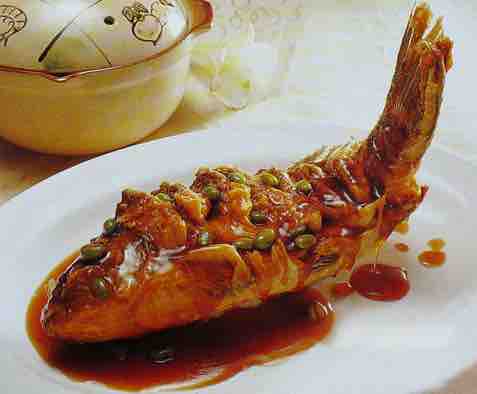Eight Culinary Traditions-Chinese Cuisine
China covers a large territory and has many nationalities, hence a variety of Chinese food with different but fantastic and mouthwatering flavor. Since China’s local dishes have their own typical characteristics, generally, Chinese food can be roughly divided into eight regional cuisines, which has been widely accepted around. Certainly, there are many other local cuisines that are famous, such as Beijing Cuisine and Shanghai Cuisine.
1. Shandong cuisine
Shandong cuisine (simplified Chinese: 山东菜; traditional Chinese: 山東菜; pinyin: Shāndōng cài), more commonly known in Chinese as Lu cuisine (simplified Chinese: 鲁菜;
traditional Chinese: 魯菜; pinyin: lǔ cài), is one the Eight Culinary Traditions (八大菜系) of Chinese cuisine and is also ranked among the Four Great Traditions (四大菜系).
It is derived from the native cooking styles of Shandong, a northern coastal province of China.
Shandong cuisine consists of two major styles:
Jiaodong style, encompassing dishes from Fushan[disambiguation needed], Qingdao and Yantai. It is characterised by seafood dishes with light tastes.
Jinan style, comprising dishes from Jinan, Dezhou and Tai’an. One of its features is the use of soup in its dishes.
2. Szechuan cuisine
Szechuan cuisine, Sichuan cuisine, or Szechwan cuisine (/ˈsɛʃwɒn/ or /ˈsɛtʃwɒn/; Chinese: 四川菜; pinyin: Sìchuān cài or Chinese: 川菜; pinyin: Chuān cài) is a style of Chinese cuisine originating from Sichuan province in southwestern China. It has bold flavours, particularly the pungency and spiciness resulting from liberal use of garlic and chili peppers, as well as the unique flavor of the Sichuan pepper. There are many local variations within Sichuan province and the Chongqing municipality, which was part of Sichuan until 1997. Four sub-styles include Chongqing, Chengdu, Zigong, and Buddhist vegetarian style.
UNESCO declared Chengdu to be a city of gastronomy in 2011 in order to recognize the sophistication of its cooking.
History
Sichuan is colloquially known as the “heavenly country” due to its abundance of food and natural resources. One ancient Chinese account declared that the “people of Sichuan uphold good flavor, and they are fond of hot and spicy taste.” Most Szechuan dishes are spicy, although a typical meal includes non-spicy dishes to cool the palate. According to at least one Chinese culinary writer,[who?] Szechuan cuisine is composed of seven basic flavours: sour, pungent, hot, sweet, bitter, aromatic, and salty. Szechuan food is divided into five different types: sumptuous banquet, ordinary banquet, popularised food, household-style food, and food snacks. Szechuan cuisine has changed little over the years, and milder versions of Sichuan dishes remain a staple of American Chinese cuisine.

3. Cantonese cuisine
Cantonese cuisine comes from Guangdong province and is one of the Eight Culinary Traditions of Chinese cuisine. Its prominence outside China is due to the great numbers of early emigrants from Guangdong. Cantonese chefs are highly sought after throughout China. When Westerners speak of Chinese food, they usually refer to Cantonese cuisine.
Background
Guangdong has long been a trading port and many imported foods and ingredients are used in Cantonese cuisine. Besides pork, beef and chicken, Cantonese cuisine incorporates almost all edible meats, including offal, chicken feet, duck’s tongue, snakes, and snails. However, lamb and goat are rarely eaten, unlike in the cuisines of northern or western China. Many cooking methods are used, with steaming and stir frying being the most favoured due to their convenience and rapidity. Other techniques include shallow frying, double steaming, braising, and deep frying.
For many traditional Cantonese cooks, the flavours of a finished dish should be well balanced and not greasy. Apart from that, spices should be used in modest amounts to avoid overwhelming the flavours of the primary ingredients, and these ingredients in turn should be at the peak of their freshness and quality. There is no widespread use of fresh herbs in Cantonese cooking, in contrast with their liberal use in other cuisines such as Sichuan, European, Thai or Vietnamese. Garlic chives and coriander leaves are notable exceptions, although the latter are usually used as mere garnish in most dishes
4. Fujian Cuisine
Fujian cuisine is one of the native Chinese cuisines derived from the native cooking style of Fujian province, China. Fujian-style cuisine is known to be light but flavourful, soft, and tender, with particular emphasis on umami taste, known in Chinese cooking as “xianwei” (simplified Chinese: 鲜味; traditional Chinese: 鮮味; pinyin: xiānwèi), as well as retaining the original flavour of the main ingredients instead of masking them.
Many diverse seafoods and woodland delicacies are used, including a myriad of fish, shellfish and turtles, or such edible mushrooms and bamboo shoots, provided by the coastal and mountainous regions of Fujian. The most commonly employed cooking techniques in the region’s cuisine include braising, stewing, steaming and boiling.
Particular attention is paid on the finesse of knife skills and cooking technique of the chefs, which is used to enhance the flavour, aroma and texture of seafood and other foods. Strong emphasis is put on the making and utilising of broth and soups. There are sayings in the region’s cuisine: “One broth can be changed into numerous (ten) forms” (simplified Chinese: 一汤十变; traditional Chinese: -湯十變; pinyin: yī tāng shí biàn) and “It is unacceptable for a meal to not have soup” (simplified Chinese: 不汤不行; traditional Chinese: 不湯不行; pinyin: bù tāng bù xíng).
Fermented fish sauce, known locally as “shrimp oil” (simplified Chinese: 虾油; traditional Chinese: 蝦油; pinyin: xiā yóu), is also commonly used in the cuisine, along with oysters, crab, and prawns. Peanuts (utilised for both savoury dishes and desserts) are also prevalent, and can be boiled, fried, roasted, crushed, ground or even turned into a paste. Peanuts can be used as a garnish, feature in soups and even be added to braised or stir-fried dishes.
Fujian cuisine consists of four styles:
Fuzhou: the taste is lighter compared to other styles, often with a mixed sweet and sour taste. Fuzhou is famous for its soups.
Western Fujian: there are often slight spicy tastes from mustard and pepper and the cooking methods are often steaming, frying and stir-frying.
Southern Fujian: spicy and sweet tastes are often found and the selection of sauces used is elaborate.
Quanzhou: the least oily but with the strongest taste/flavour of Fujian cuisine. Great emphasis is placed on the shape of the material for each dish.
5. Jiangsu Cuisine
Jiangsu cuisine (simplified Chinese: 江苏菜; traditional Chinese: 江蘇菜; pinyin: Jiāngsū cài), abbreviated to Su cuisine (simplified Chinese: 苏菜; traditional Chinese: 蘇菜; pinyin: sū cài), is one the Eight Culinary Traditions of Chinese cuisine. It is derived from the native cooking styles of Jiangsu province. In general, Jiangsu cuisine’s texture is characterised as soft, but not to the point of mushy or falling apart. For example, the meat tastes quite soft but would not separate from the bone when picked up. Other characteristics includes the strict selection of ingredients according to the seasons, emphasis on the matching colour and shape of each dish and emphasis on using soup to improve flavour.
Regional variations
Jiangsu cuisine is sometimes simply called Su cuisine, and one of its major styles is Huaiyang cuisine. Although Huaiyang cuisine is one of several sub-regional styles within Jiangsu cuisine, it is widely seen in Chinese culinary circles as the most popular and prestigious style of the Jiangsu cuisine – to a point where it is considered to be amongst one of the four most influential regional schools (四大菜系) that dominate the culinary heritage of China, along with Cantonese cuisine, Shandong cuisine and Sichuan cuisine.
Jiangsu cuisine actually consists of several other styles, including:
Cuisine Description
Nanjing Its dishes emphasize an even taste and matching colour, with dishes incorporating river fish/shrimps and duck.
Suzhou Emphasis on the selection of material, stronger taste than Nanjing cuisine, and with a tendency to be sweeter than the other varieties of the cuisine.
Wuxi Its proximity to Lake Tai means it is notable for wide variety of freshwater produce, such as the “Three Whites” – white bait (simplified Chinese: 银鱼; traditional Chinese: 銀魚; pinyin: yín yú), white fish (simplified Chinese: 白鱼; traditional Chinese: 白魚; pinyin: bái yú) and white shrimp (simplified Chinese: 白虾; traditional Chinese: 白蝦; pinyin: bái xiā).
6. Zhejiang Cuisine
Zhejiang cuisine (Chinese: 浙菜, p Zhècài) is one of the 8 Culinary Traditions of Chinese cuisine. It derives from the traditional ways of cooking in Zhejiang province in China, south of Shanghai and around the former Chinese capital of Hangzhou. In general, Zhejiang-style food is not greasy but has a fresh and soft flavour with a mellow fragrance.
Zhejiang cuisine consists of at least three styles, each originating from a city in the province:
Hangzhou style, characterised by rich variations and the utilisation of bamboo shoots. It is served by restaurants such as the Dragon Well Manor.
Shaoxing style, specialising in poultry and freshwater fish.
Ningbo style, specialising in seafood, with emphasis on freshness and salty dishes.
Some sources also include the Wenzhou style as a separate subdivision (due to its proximity to Fujian), characterised as the greatest source of seafood as well as poultry and livestock.
7. Hunan Cuisine
Hunan cuisine, also known as Xiang cuisine, consists of the cuisines of the Xiang River region, Dongting Lake, and western Hunan province in China. It is one of the Eight Great Traditions of Chinese cuisine and is well known for its hot spicy flavour, fresh aroma and deep colour. Common cooking techniques include stewing, frying, pot-roasting, braising, and smoking. Due to the high agricultural output of the region, ingredients for Hunan dishes are many and varied.
Features
Known for its liberal use of chili peppers, shallots and garlic, Hunan cuisine is known for being dry hot (干辣) or purely hot, as opposed to Sichuan cuisine, to which it is often compared. Sichuan cuisine is known for its distinctive mala (hot and numbing) seasoning and other complex flavour combinations, frequently employs Sichuan peppercorns along with chilies which are often dried, and utilises more dried or preserved ingredients and condiments. Hunan cuisine, on the other hand, is often spicier by pure chili content, contains a larger variety of fresh ingredients, and tends to be oilier. Another characteristic distinguishing Hunan cuisine from Sichuan cuisine is that, in general, Hunan cuisine uses smoked and cured goods in its dishes much more frequently.
Another feature of Hunan cuisine is that the menu changes with the seasons. In a hot and humid summer, a meal will usually start with cold dishes or a platter holding a selection of cold meats with chilies for opening the pores and keeping cool in the summer. In winter, a popular choice is the hot pot, thought to heat the blood in the cold months. A special hot pot called yuanyang huoguo (simplified Chinese: 鸳鸯火锅; traditional Chinese: 鴛鴦火鍋; pinyin: yuānyāng hǔogūo; literally: “lovers’ hot pot”) is notable for splitting the pot into two sides – a spicy one and a non-spicy one.
8. Anhui Cuisine
Anhui cuisine (Chinese: 安徽菜; pinyin: Ānhuī cài), or Hui cuisine (Chinese: 徽菜; pinyin: huī cài), is one of the Eight Culinary Traditions of Chinese cuisine. It is derived from the native cooking styles of the Huangshan Mountains region in China and is similar to Jiangsu cuisine.
Methods and ingredients
Anhui cuisine is known for its use of wild herbs, from both the land and the sea, and simple methods of preparation. Braising and stewing are common cooking techniques. Frying and stir frying are used much less frequently in Anhui cuisine than in other Chinese culinary traditions.[citation needed] Anhui cuisine consists of three styles: the Yangtze River region, Huai River region, and southern Anhui region. Anhui has ample uncultivated fields and forests, so the wild herbs used in the region’s cuisine are readily available.
Recommend:








